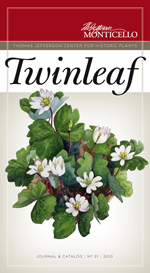 There are a variety of plants that Thomas Jefferson recorded which are intriguing not just because they are unusual or rare or uncommon in the gardens of his time, but also because they lead us to speculate about how they might have been grown. Staking, pruning, and training techniques, for example, are not generally spelled out in his correspondence and memoranda. We wonder how he dealt with those exuberant climbers that grow beyond reasonable bounds, reaching outward and upward toward sun and space.
There are a variety of plants that Thomas Jefferson recorded which are intriguing not just because they are unusual or rare or uncommon in the gardens of his time, but also because they lead us to speculate about how they might have been grown. Staking, pruning, and training techniques, for example, are not generally spelled out in his correspondence and memoranda. We wonder how he dealt with those exuberant climbers that grow beyond reasonable bounds, reaching outward and upward toward sun and space.
Plants that sprawl and trail come in many forms: from tender annuals to long-lived woody shrubs. Their allure is often enhanced by a sense of wildness that they bring to an otherwise tame and tidy garden. But, regardless of their many attributes, climbers and ramblers will eventually present a quandary akin to that which is experienced with the likes of Leyland cypress, zucchinis, and baby alligators: "what do you do with them when they grow up?"
"By their wild Appearance, they will be agreeable enough" –Philip Miller
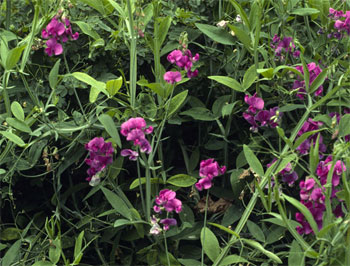 Jefferson, in his early conceptual designs for the Monticello landscape, seemed to take a naturalist, laissez-fair approach regarding the native vines and climbing species that he wished to cultivate. In 1771, at the age of 28, he made elaborate plans for the grounds of his Little Mountain, in which he specified that "Jessamine [Gelsemium sempervirens], honeysuckle [Lonicera sempervirens], sweetbriar [Rosa eglanteria], and even hardy flowers which may not require attention" should be interspersed throughout the landscape. His fanciful idea for a grotto at the North Spring included "an abundance of Jesamine, Honeysuckle, sweet briar, etc." And his plant lists for "The Open Ground on the West—a shrubbery" contained "Climbing shrubby plants—Trumpet flower [either Campsis radicans or Bignonia capreolata]—Jasmine—Honeysuckle." He included the perennial or everlasting pea, Lathyrus latifolius, in his list of perennial flowers and he also added honeysuckle, Jessamine, and poison ivy, Rhus radicans, in his list of trees, suggesting that he considered these plants, which can grow fifty feet or more, to be in the same category as the trees they climbed upon.
Jefferson, in his early conceptual designs for the Monticello landscape, seemed to take a naturalist, laissez-fair approach regarding the native vines and climbing species that he wished to cultivate. In 1771, at the age of 28, he made elaborate plans for the grounds of his Little Mountain, in which he specified that "Jessamine [Gelsemium sempervirens], honeysuckle [Lonicera sempervirens], sweetbriar [Rosa eglanteria], and even hardy flowers which may not require attention" should be interspersed throughout the landscape. His fanciful idea for a grotto at the North Spring included "an abundance of Jesamine, Honeysuckle, sweet briar, etc." And his plant lists for "The Open Ground on the West—a shrubbery" contained "Climbing shrubby plants—Trumpet flower [either Campsis radicans or Bignonia capreolata]—Jasmine—Honeysuckle." He included the perennial or everlasting pea, Lathyrus latifolius, in his list of perennial flowers and he also added honeysuckle, Jessamine, and poison ivy, Rhus radicans, in his list of trees, suggesting that he considered these plants, which can grow fifty feet or more, to be in the same category as the trees they climbed upon.
Jefferson's vision echoed the British horticultural writer Philip Miller, author of the seminal work The Gardener's Dictionary. In fact, the 1768 edition of this tome resided in Jefferson's library. Miller wrote that such trailing plants, "...should be planted in Large Wilderness-quarters, near the Stems of great Trees, to which they should be trained up; where, by their wild Appearance, they will be agreeable enough." This idea of allowing ramblers to creep through the shrubbery and encircle the bases of trees was, in fact, pioneered a generation earlier by the influential English landscape writer Batty Langley in New Principles of Gardening (1728). Each of the high-reaching vines Jefferson listed has very desirable ornamental features, such as fragrance, showy flowers of vivid yellow, light lavender, warm cantaloupe-orange, or bright red, and, in the case of poison ivy, brilliant fall color.
In 1807, as Jefferson approached retirement from his second Presidential term, he noted in his Garden Book on April 27 that seeds of the North American clematis, or virgin's bower, Clematis virginiana, were planted "about the 3. springs on & near the road from the river up to the house & at the Stone spring." Here again, Jefferson's intention to create a scene where the vine tumbles and cascades over the woodland springs with a shower of fragrant, creamy-white flowers resonates with Philip Miller's dictionary entry for clematis in which he wrote: "These may also be planted to cover Seats in Wilderness-quarters, that are designed for shade; to which Purpose these Plants are very well adapted."
"Stick some Rough boughs ... for them to ramp upon..." –Philip Miller
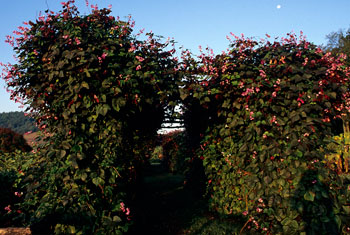 In the restored Monticello vegetable garden, the most prominent structural feature for supporting climbers is Jefferson's arbor—an enormous twelve-foot-high structure made of locust posts and cedar rails. Jefferson intended this design for his vineyard, so the present-day construction along the southwest grass walk border of the vegetable garden is speculative. But, we know some type of arbor was used for, according to Jefferson's Garden Book entry for April 17, 1812, "arbor beans white, scarlet, crimson, purple..." were planted. The scarlet runner bean, Phaseolus coccineus—which flowers in white, scarlet, or scarlet and white bicolor forms—was the most likely candidate. It was common in English Gardens both for the kitchen and, as Miller wrote, "...to cover Arbours, and other Seats, in the Summer season, to afford Shade..." But the purple-flowering variety could have been the hyacinth bean, Dolichos lablab (syn. Lablab purpureus), which dominates the present-day arbor and more successfully withstands the hot Central Virginia summers than does the cool-weather loving scarlet runner. The Hyacinth Bean, a luxuriant climber covered with rich-purple foliage and deep lavender (or occasionally white) flowers, is one of the most dramatic and eye-catching elements in the Monticello vegetable garden today. From late summer through the first hard freeze the vines' thick, ropy stems twine around the bean arbor and, from the vantage of Mulberry Row overlooking the garden, Monticello visitors often mistake the flowers for clusters of luscious grapes hanging in abundance.
In the restored Monticello vegetable garden, the most prominent structural feature for supporting climbers is Jefferson's arbor—an enormous twelve-foot-high structure made of locust posts and cedar rails. Jefferson intended this design for his vineyard, so the present-day construction along the southwest grass walk border of the vegetable garden is speculative. But, we know some type of arbor was used for, according to Jefferson's Garden Book entry for April 17, 1812, "arbor beans white, scarlet, crimson, purple..." were planted. The scarlet runner bean, Phaseolus coccineus—which flowers in white, scarlet, or scarlet and white bicolor forms—was the most likely candidate. It was common in English Gardens both for the kitchen and, as Miller wrote, "...to cover Arbours, and other Seats, in the Summer season, to afford Shade..." But the purple-flowering variety could have been the hyacinth bean, Dolichos lablab (syn. Lablab purpureus), which dominates the present-day arbor and more successfully withstands the hot Central Virginia summers than does the cool-weather loving scarlet runner. The Hyacinth Bean, a luxuriant climber covered with rich-purple foliage and deep lavender (or occasionally white) flowers, is one of the most dramatic and eye-catching elements in the Monticello vegetable garden today. From late summer through the first hard freeze the vines' thick, ropy stems twine around the bean arbor and, from the vantage of Mulberry Row overlooking the garden, Monticello visitors often mistake the flowers for clusters of luscious grapes hanging in abundance.
Probably the most spectacular vine for the garden arbor is yet another ornamental legume: the show-stopping snail flower or Caracalla bean, Vigna caracalla. Despite its curious common name, Thomas Jefferson justly called it "The most beautiful bean in the world." Philip Miller's Dictionary (1768) described it as: "... a kidney-bean with a twining stalk ... [which] grows naturally in the Brazils, from whence the seeds were brought to Europe." Miller observed further: "It is very common in Portugal, where the inhabitants plant it to cover arbours and seats in gardens, for which it is greatly esteemed ..., for its beautiful sweet smelling flowers."
Since Jefferson's time, fashion has dictated the rise and fall of the Caracalla's popularity. During the 1890s, New York nurseryman Peter Henderson claimed that the bluish-lilac flowers were "valued by florists for their delicious fragrance and for their resemblance to Orchids." By the early twentieth century, however, Liberty Hyde Bailey's Cyclopaedia observed, "It is an old-fashioned glasshouse plant in cold climates, but is now rarely seen." Thanks to Monticello's success in displaying and reintroducing this vine to the public, the snail flower is now more well-known and coveted by American gardeners than ever.
Philadelphia nurseryman Bernard McMahon, who is considered Jefferson's gardening mentor, offered very detailed instructions for staking runner beans and other climbers in his book, The American Gardener's Calendar (1806), another important reference in Jefferson's library. For running kidney beans and Carolina lima beans, McMahon advised the gardener to "place two or three tall poles to each hill for them to climb on." While it's not clear if McMahon meant for the poles to stand straight up or brought together, today's vegetable gardeners at Monticello bind four poles at the top to create a four-sided teepee. These poles are narrower than the heavy locust posts of the arbor, allowing the vines to twine more easily, and they can be moved to different parts of the garden each year.
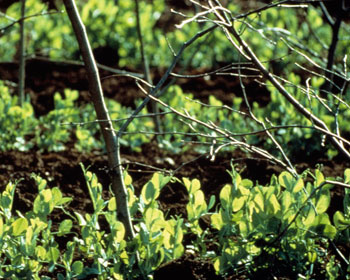 For shorter climbers with tender tendrils, such as English peas, "sticking" has historically been the method of choice. Philip Miller's instructions for his eighteenth-century audience were rather bluntly put: "when the Plants are grown eight or ten inches high, you should stick some rough Boughs, or Brush-wood, into the Ground close to the Peas, for them to ramp upon..." But McMahon offered greater details and alternative methods for American gardeners in his Calendar (1806):
For shorter climbers with tender tendrils, such as English peas, "sticking" has historically been the method of choice. Philip Miller's instructions for his eighteenth-century audience were rather bluntly put: "when the Plants are grown eight or ten inches high, you should stick some rough Boughs, or Brush-wood, into the Ground close to the Peas, for them to ramp upon..." But McMahon offered greater details and alternative methods for American gardeners in his Calendar (1806):
"As to sticking peas, always be careful to have this done when they are about six inches high; ... and if they are double sticked, the better; that is, place a range of sticks on the one side, all in a regular declining manner, and another on the other side of the row declining in an opposite direction to the former, by which, none can fall out on either side."
"Otherwise [the vines] will ramble and trail upon the ground, and appear very unsightly" –Philip Miller
The flower gardens at Monticello offer different challenges for displaying climbers in an appropriate style for the period. Eighteenth-century British garden authorities, who often made a big point of what was and was not considered proper in the "Pleasure Garden," deemed that the sticking method was just as acceptable for ornamental plantings of sweet-scented peas, Lathyrus odoratus, as for the edible sorts in the vegetable garden.
Miller discussed the three sweet-pea varieties known at the time, the ones he described as bearing"...purple, white, and 'pale-red' flowers, which is commonly called by the Gardeners, Painted-lady Peas." He continued with the following cultural directions:
"Where they are sown for Ornament, there should be six or eight seeds sown in a small Patch, in different Parts of the Borders of the Flower-garden; and ... when they are grown two or three Inches high, there should be some Sticks put down by them to support them; otherwise they will trail on the Ground, and become unsightly; besides they will trail on whatever Plants grow near them."
Two-and-a- half centuries later, Monticello gardeners continue this technique for the 'Painted Lady' sweet-pea beds along the restored winding flower walk on the West Lawn.
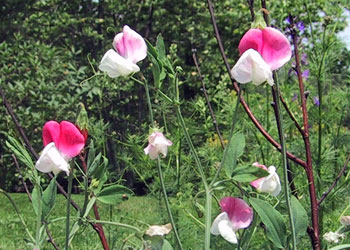 But the delicate, spring-flowering sweet peas are relatively well behaved when compared to the more rambunctious, heat-loving, summer climbers that Jefferson documented. Annual vines like the balsam apple (Momordica balsamina) and cypress vine (Ipomoea quamoclit) grow much taller than the sweet pea, and are wont to cover and smother whatever supports them. Growing these vines at the Center for Historic Plants Tufton nursery is easily accomplished with an eight-foot high wooden frame structure covered with chicken wire. By summer's end, the tangle of cypress vine and balsam apple foliage creates a stunning combination of fine and coarse textures surrounding the balsam apples' bizarre, bright-orange fruits. Keeping these climbers contained and reined into the ten-foot long compartments of the winding flower border at Monticello is quite another story. Without the support of a fence, wall, or lattice work, one solution with tolerable results has been simply to use longer pea sticks and to allow the vines to spill over the tops of spring-flowering perennials such as peonies.
But the delicate, spring-flowering sweet peas are relatively well behaved when compared to the more rambunctious, heat-loving, summer climbers that Jefferson documented. Annual vines like the balsam apple (Momordica balsamina) and cypress vine (Ipomoea quamoclit) grow much taller than the sweet pea, and are wont to cover and smother whatever supports them. Growing these vines at the Center for Historic Plants Tufton nursery is easily accomplished with an eight-foot high wooden frame structure covered with chicken wire. By summer's end, the tangle of cypress vine and balsam apple foliage creates a stunning combination of fine and coarse textures surrounding the balsam apples' bizarre, bright-orange fruits. Keeping these climbers contained and reined into the ten-foot long compartments of the winding flower border at Monticello is quite another story. Without the support of a fence, wall, or lattice work, one solution with tolerable results has been simply to use longer pea sticks and to allow the vines to spill over the tops of spring-flowering perennials such as peonies.
Jefferson recorded the planting of the everlasting pea, Lathyrus latifolius, on two occasions in his Garden Book. The first planting, mentioned previously, was part of his 1771 scheme for "The Open Ground on the West—a Shrubbery" at Monticello. The second time, it was displayed prominently in an oval flower bed on Monticello's East Front as part of Jefferson's 1807 flower garden plans. The everlasting pea in Jefferson's shrubbery likely reflected the style of the British wilderness garden, in which Miller wrote: "These plants are very proper to plant against a dead hedge, where they will run over it; and if they be kept train'd up, will cover it in the Summer." With growth to nine feet, the everlasting pea is too tall and lanky for the traditional pea-sticking method. Might the vines have been staked with something more substantial in the oval flower bed? Or, could they have been coupled with climbing, spring-flowering shrubs such as roses, where the purple flowers of the perennial pea would extend the season with a summer display? Whether staked, trellised, trained on shrubbery, or regularly pruned to the ground, given its prominent position adjacent to his south terrace and green house, Thomas Jefferson most certainly harbored a fondness for this vine, an opinion which is not as enthusiastically embraced by modern gardeners. Perhaps, like the snail flower, the everlasting pea has yet to enjoy a renaissance of sorts.